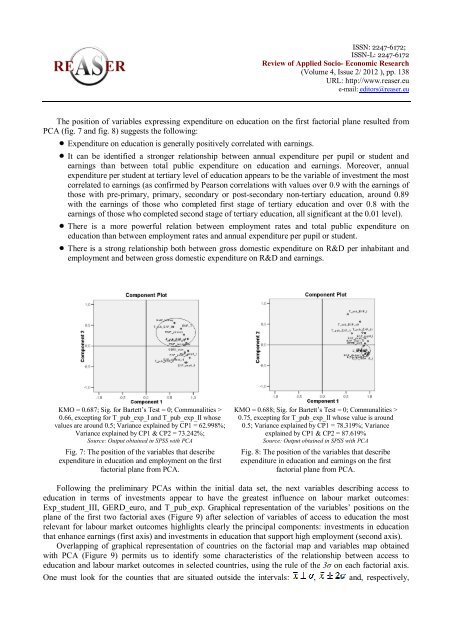How does education affect labour market outcomes? - Review of ...
How does education affect labour market outcomes? - Review of ...
How does education affect labour market outcomes? - Review of ...
You also want an ePaper? Increase the reach of your titles
YUMPU automatically turns print PDFs into web optimized ePapers that Google loves.
ISSN: 2247-6172;ISSN-L: 2247-6172<strong>Review</strong> <strong>of</strong> Applied Socio- Economic Research(Volume 4, Issue 2/ 2012 ), pp. 138URL: http://www.reaser.eue-mail: editors@reaser.euThe position <strong>of</strong> variables expressing expenditure on <strong>education</strong> on the first factorial plane resulted fromPCA (fig. 7 and fig. 8) suggests the following: Expenditure on <strong>education</strong> is generally positively correlated with earnings. It can be identified a stronger relationship between annual expenditure per pupil or student andearnings than between total public expenditure on <strong>education</strong> and earnings. Moreover, annualexpenditure per student at tertiary level <strong>of</strong> <strong>education</strong> appears to be the variable <strong>of</strong> investment the mostcorrelated to earnings (as confirmed by Pearson correlations with values over 0.9 with the earnings <strong>of</strong>those with pre-primary, primary, secondary or post-secondary non-tertiary <strong>education</strong>, around 0.89with the earnings <strong>of</strong> those who completed first stage <strong>of</strong> tertiary <strong>education</strong> and over 0.8 with theearnings <strong>of</strong> those who completed second stage <strong>of</strong> tertiary <strong>education</strong>, all significant at the 0.01 level). There is a more powerful relation between employment rates and total public expenditure on<strong>education</strong> than between employment rates and annual expenditure per pupil or student. There is a strong relationship both between gross domestic expenditure on R&D per inhabitant andemployment and between gross domestic expenditure on R&D and earnings.KMO = 0.687; Sig. for Bartett’s Test = 0; Communalities >0.66, excepting for T_pub_exp_I and T_pub_exp_II whosevalues are around 0.5; Variance explained by CP1 = 62.998%;Variance explained by CP1 & CP2 = 73.242%;Source: Output obtained in SPSS with PCAFig. 7: The position <strong>of</strong> the variables that describeexpenditure in <strong>education</strong> and employment on the firstfactorial plane from PCA.KMO = 0.688; Sig. for Bartett’s Test = 0; Communalities >0.75, excepting for T_pub_exp_II whose value is around0.5; Variance explained by CP1 = 78.319%; Varianceexplained by CP1 & CP2 = 87.619%Source: Output obtained in SPSS with PCAFig. 8: The position <strong>of</strong> the variables that describeexpenditure in <strong>education</strong> and earnings on the firstfactorial plane from PCA.Following the preliminary PCAs within the initial data set, the next variables describing access to<strong>education</strong> in terms <strong>of</strong> investments appear to have the greatest influence on <strong>labour</strong> <strong>market</strong> <strong>outcomes</strong>:Exp_student_III, GERD_euro, and T_pub_exp. Graphical representation <strong>of</strong> the variables’ positions on theplane <strong>of</strong> the first two factorial axes (Figure 9) after selection <strong>of</strong> variables <strong>of</strong> access to <strong>education</strong> the mostrelevant for <strong>labour</strong> <strong>market</strong> <strong>outcomes</strong> highlights clearly the principal components: investments in <strong>education</strong>that enhance earnings (first axis) and investments in <strong>education</strong> that support high employment (second axis).Overlapping <strong>of</strong> graphical representation <strong>of</strong> countries on the factorial map and variables map obtainedwith PCA (Figure 9) permits us to identify some characteristics <strong>of</strong> the relationship between access to<strong>education</strong> and <strong>labour</strong> <strong>market</strong> <strong>outcomes</strong> in selected countries, using the rule <strong>of</strong> the 3σ on each factorial axis.One must look for the counties that are situated outside the intervals: , and, respectively,








